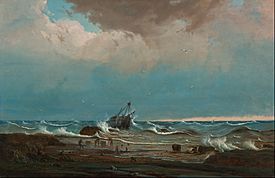George III (ship) facts for kids
class="infobox " style="float: right; clear: right; width: 315px; border-spacing: 2px; text-align: left; font-size: 90%;"
| colspan="2" style="text-align: center; font-size: 90%; line-height: 1.5em;" | 
|} The George III was a British convict ship built in London in 1810. This type of ship was used to transport prisoners, called convicts, from England to the Australian Colonies. Sadly, the George III was wrecked during one of these journeys. It sank in the southern part of the D'Entrecasteaux Channel near Van Diemen's Land (which is now called Tasmania). Out of 294 people on board, 134 lost their lives.
Contents
| History | |
|---|---|
| Name | George III |
| Namesake | George III of the United Kingdom |
| Owner | J. Heathorn and J. Poore in the mid-1830s. |
| Builder | John Dudman & Co., Deptford, London |
| Launched | 4 June 1810 |
| Homeport | Port of London |
| Fate | Wrecked 12 March 1835 |
| General characteristics | |
| Tons burthen | 383, or 394, or 399, or 39918⁄94 (bm) |
| Length | 114 ft (35 m) |
| Beam | 28 ft 3 in (8.61 m) |
| Sail plan | Full-rigged ship |
| Crew | 35 |
| Armament | 16 × 12-pounder carronades |
The Convict Ship George III
Early Voyages
The George III began its life as a transport ship. Its captain, Alexander Scott, received a special permit called a letter of marque in August 1810. This permit allowed the ship to capture enemy vessels during wartime.
From 1810 onwards, the George III was listed in Lloyd's Register, a record of ships. It often sailed between London and Jamaica. Over the years, the ship had different captains and owners. It also underwent several repairs to fix damages it received during its voyages.
A Tragic Journey
The George III's final voyage began on December 14, 1834. It set sail from Woolwich, England, heading for Hobart Town in Van Diemen's Land. Captain William Hall-Moxey was in command. There were 308 people on board. This included 220 male convicts, along with guards, their families, and the ship's crew.
Challenges at Sea
On January 27, 1835, a fire broke out on the ship as it neared the equator. The crew managed to put out the fire, but it destroyed some of the ship's food supplies. Because of this, everyone on board had to go on reduced food portions. This unbalanced diet led to an outbreak of scurvy, a serious illness caused by a lack of vitamin C. Fourteen convicts died from scurvy before the ship even reached the coast of Van Diemen's Land.
The Shipwreck
On the morning of March 12, 1835, the ship finally reached the coast. To avoid being pushed back out to sea by strong winds, Captain Hall-Moxey decided to enter the D'Entrecasteaux Channel. This channel was known for being difficult to navigate.
Around 9:15 PM that evening, the George III hit a hidden rock. Over the next few hours, the ship slowly broke apart in the rough waves. The convicts were kept below deck so that the women and children could be safely taken off the ship in lifeboats. Guards fired their guns to control the situation, and some convicts sadly died during this chaos. Many others drowned below decks, including those who were already sick in their beds. In total, 133 people died in the disaster, and 128 of them were convicts.
The Inquiry and Its Impact
After the shipwreck, an official investigation was held. This inquiry did not place blame on any specific person for the disaster. However, the tragedy led to important changes. It encouraged new efforts to create more accurate nautical charts (sea maps) of the Tasmanian coast. These new maps would warn sailors about the many dangerous rocks and shallow areas. The disaster also resulted in stricter rules about the food and supplies that convict ships had to carry.
Local Stories and Legends
Over time, local stories and legends grew around the shipwreck of the George III. One popular belief was that convicts were released into the sea and then shot by the ship's officers. Another part of the legend claimed that a ten-year-old cabin boy was the only convict to survive, hidden by the captain's wife.
However, historical records show that the captain's wife was not on board the ship. Also, many survivors were rescued much faster than some stories suggest. The ship's longboat made trips to shore, and another schooner, the Louisa, arrived from Hobart Town to help. These legends likely mixed facts with dramatic details, perhaps influenced by the feelings of former convicts who settled in the area.
One famous story tells of a soldier's wife, Mrs. Martin, who was described as very brave. A lithograph (a type of print) was made showing her holding her two babies and an older child for 48 hours in the cold and rain. While Mrs. Martin was indeed brave, all survivors were rescued by the next morning, not 48 hours later.
Memorials to the Lost
A special memorial plaque for the George III is located at the Tasmanian Seafarers Memorial in Triabunna, on the east coast of Tasmania. This is about 80 km (50 mi) north-east of Hobart.
The plaque reads:
George III
Convict ship of 308 tons left England
14/12/1834 with 34 crew, 200 convicts
and 29 soldiers of the 50th Regiment.
After 118 days, 16 dead, 60 had scurvy.
Then 10.4.1835 struck submerged rocks
in D'Entrecasteaux Channel, V.D.L.
resulting in the loss of 134 souls.
There is also a tourist sign at Southport that has been updated by the Australian Government. It now explains that an inquiry into the shipwreck and the alleged shootings found no proof of wrongdoing. Another monument can be found at Southport Bluff, which can be reached by the Ida Bay railway and a walking path. However, this monument cannot currently be visited due to conservation reasons.

